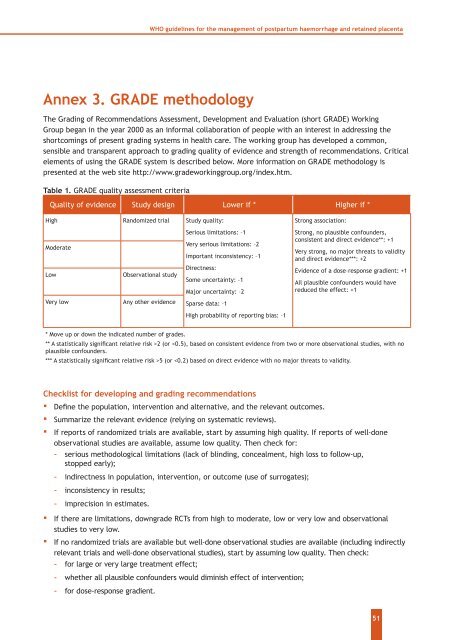WHO guidelines for the management of postpartum haemorrhage ...
WHO guidelines for the management of postpartum haemorrhage ...
WHO guidelines for the management of postpartum haemorrhage ...
Create successful ePaper yourself
Turn your PDF publications into a flip-book with our unique Google optimized e-Paper software.
<strong>WHO</strong> <strong>guidelines</strong> <strong>for</strong> <strong>the</strong> <strong>management</strong> <strong>of</strong> <strong>postpartum</strong> <strong>haemorrhage</strong> and retained placenta<br />
Annex 3. GRADE methodology<br />
The Grading <strong>of</strong> Recommendations Assessment, Development and Evaluation (short GRADE) Working<br />
Group began in <strong>the</strong> year 2000 as an in<strong>for</strong>mal collaboration <strong>of</strong> people with an interest in addressing <strong>the</strong><br />
shortcomings <strong>of</strong> present grading systems in health care. The working group has developed a common,<br />
sensible and transparent approach to grading quality <strong>of</strong> evidence and strength <strong>of</strong> recommendations. Critical<br />
elements <strong>of</strong> using <strong>the</strong> GRADE system is described below. More in<strong>for</strong>mation on GRADE methodology is<br />
presented at <strong>the</strong> web site http://www.gradeworkinggroup.org/index.htm.<br />
Table 1. GRADE quality assessment criteria<br />
Quality <strong>of</strong> evidence Study design Lower if * Higher if *<br />
High Randomized trial Study quality:<br />
Strong association:<br />
Moderate<br />
Low<br />
Observational study<br />
Serious limitations: –1<br />
Very serious limitations: –2<br />
Important inconsistency: –1<br />
Directness:<br />
Some uncertainty: –1<br />
Major uncertainty: –2<br />
Strong, no plausible confounders,<br />
consistent and direct evidence**: +1<br />
Very strong, no major threats to validity<br />
and direct evidence***: +2<br />
Evidence <strong>of</strong> a dose–response gradient: +1<br />
All plausible confounders would have<br />
reduced <strong>the</strong> effect: +1<br />
Very low<br />
Any o<strong>the</strong>r evidence<br />
Sparse data: –1<br />
High probability <strong>of</strong> reporting bias: –1<br />
* Move up or down <strong>the</strong> indicated number <strong>of</strong> grades.<br />
** A statistically significant relative risk >2 (or 5 (or
















